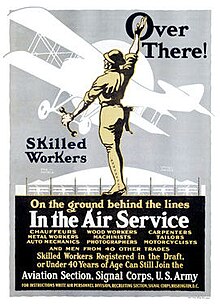Organization of the Air Service of the American Expeditionary Force

World War I Air Service recruiting poster, 1918
|
|
| Active | 3 September 1917 - 1919 |
|---|---|
| Country |
|
| Branch | United States Army Air Service |
| Part of | American Expeditionary Forces |
| Commanders | |
| Chief of Air Service, American Expeditionary Forces, 3 September 1917 | William L. Kenly |
| Chief of Air Service, American Expeditionary Forces, 27 November 1917 | Benjamin Foulois |
| Chief of Air Service, American Expeditionary Forces, 19 May 1918 | Mason Patrick |
| Insignia | |
| Wing roundel of Air Service, United States Army aircraft |  |
The Organization of the Air Service of the American Expeditionary Force on November 11, 1918 represents its maximum strength in World War I. Units of the Air Service are listed as assigned to the order of battle for that date, which was that of the Armistice with Germany. The first air unit arrived in France in September 1917, while the final air unit reaching the front did so on November 9, 1918. Unit operations began in April 1918. At the armistice, 57,508 officers and men served in the Air Service of the AEF, 24,512 in the Zone of Advance (combat area), and 32,996 in the Services of Supply (rear areas). Of its 6,861 officers, 4,088 were on flying status and 219 were qualified observation balloon aviators. 1,724 of those on flying status and approximately 100 of the balloonists served in combat units.
The First Army Air Service was activated August 26, 1918, with Col. Benjamin Foulois named chief over Col. Billy Mitchell. The Air Service, Second Army Air Service was activated on October 12 with Col. Frank P. Lahm as chief, and the Air Service, Third Army Air Service was created immediately after the armistice to provide aviation support to the army of occupation, primarily from veteran units transferred from the First Army Air Service.
The first two air combat groups formed in the AEF were the 1st Corps Observation Group, in April 1918, and the 1st Pursuit Group at Toul. Ultimately fourteen airplane and seven balloon groups were formed to support the operations of two field armies and five corps. The five pursuit and two bombardment groups were organized into two wings. The seven observation and seven balloon groups had one of each assigned to an army or corps air service. Two flexible "observation wings" were created to coordinate the reconnaissance activities of the five corps air services.
...
Wikipedia
